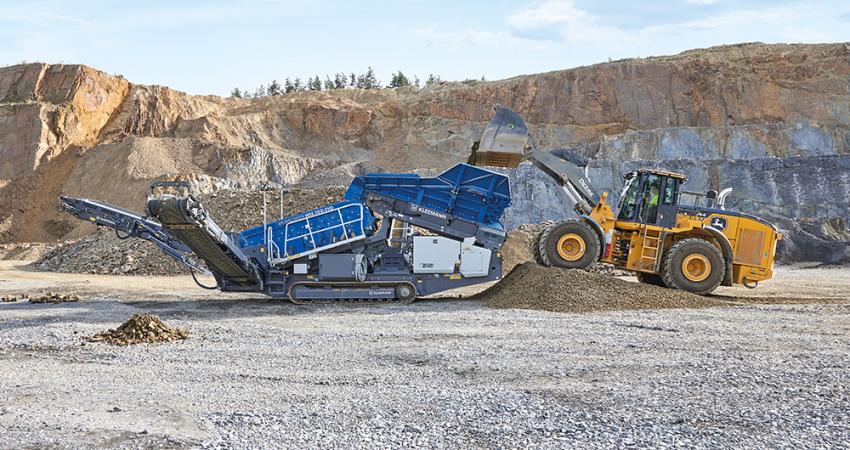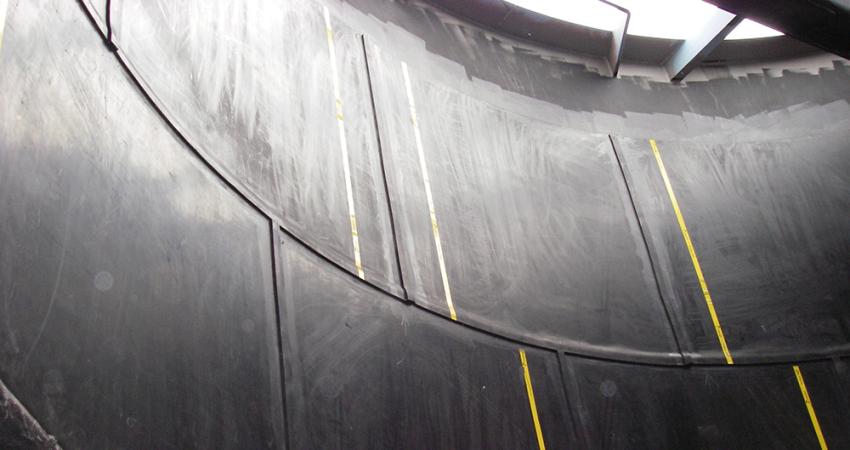
Cement making is particularly energy-intensive. To reduce the use of valuable primary fuels like coal, German building materials giant HeidelbergCement uses alternative fuels, including waste tyres, at its cement plant in Lengfurt, Bavaria. The calorific value of rubber is comparable to that of hard coal. And because the iron from the armouring can be incorporated mineralogically into the cement, it reduces the need to add ferrous corrective substances.
For the Lengfurt plant, BEUMER supplied and installed a fully automated waste-tyre transport system, including conveyors, that sorts, separates and regulates the tyres of different sizes and weights and feeds them to the rotary kiln inlet. Thanks to the new system, the cement plant’s kiln is now fed with a constant stream of material.
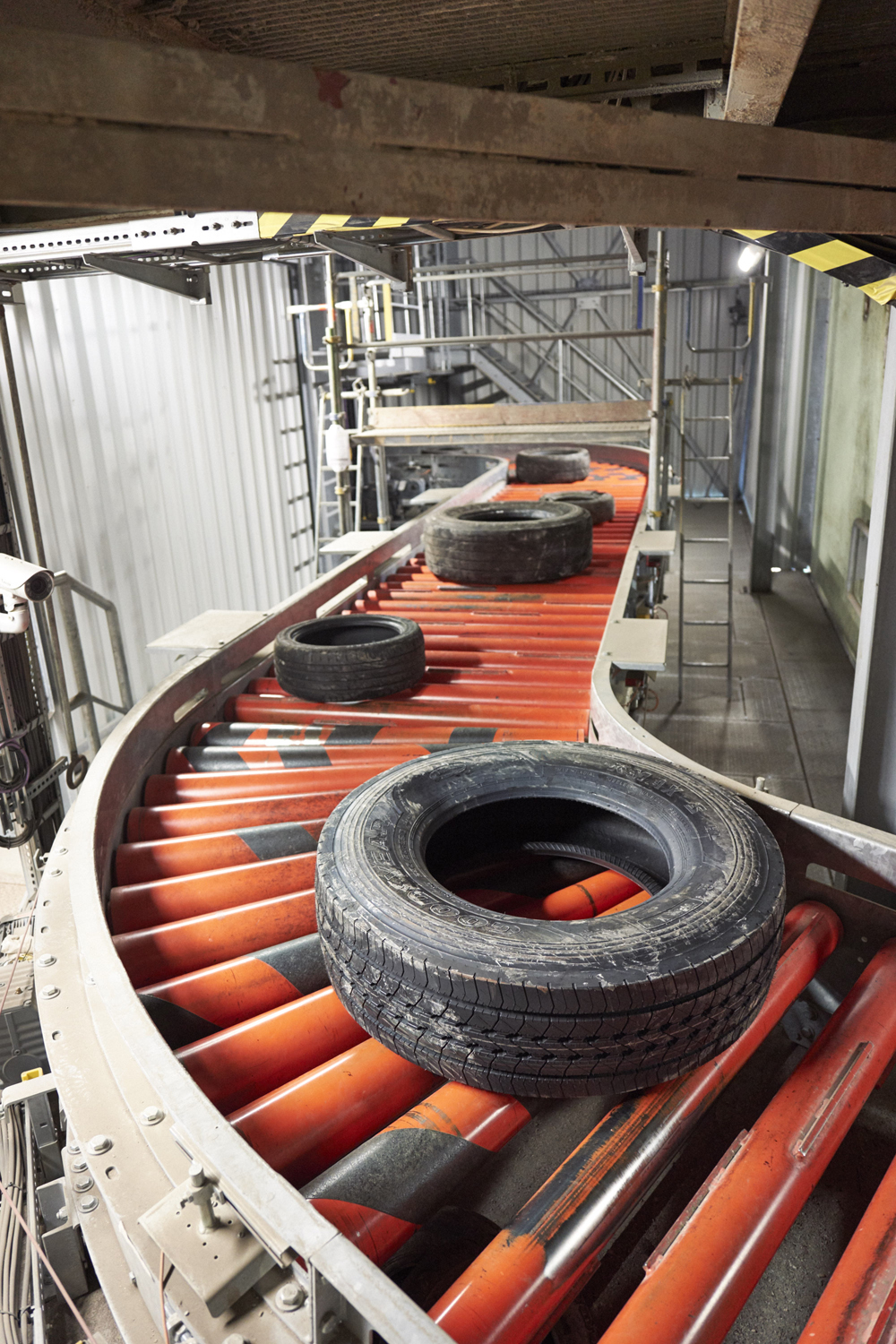
“With every tonne of waste tyres that we’re using, we’re replacing the same amount of valuable hard coal,” explains Michael Becker, director of HeidelbergCement’s Lengfurt site.
“Waste tyres have a high heat content, meaning that they are the ideal fuel for our production,” adds Becker. About 20,000 tonnes of hard coal are used in the plant annually to produce circa 20% of the overall heat we require. This corresponds to 20 million tyres. This is how we can substitute the primary fuel with the tyres as secondary fuel.”
The waste tyres used by the plant vary greatly; their diameters range from 300 to 1,600 millimetres, and their widths between 100 and 400 millimetres. The average weight is eight kilograms for car tyres and around 60 kilograms for truck tyres.
To feed the different tyre material to the rotary kiln inlet, HeidelbergCement used to operate two waste-tyre transport systems: one line transported the smaller and lighter car tyres, the other one the larger and heavier truck tyres.
“We didn’t think that this solution was efficient enough,” says Becker. “Our employees hung the tyres individually by hand into the hook lift and then transported into the kiln inlet. The heavy truck tyres were handled by an excavator before they were fed into the transport stream. With the new fully automatic system we were able to not only improve this process with regard to occupational safety, but also optimise the working conditions for our employees in combination with an increased performance. We already had a great experience with solutions from BEUMER in other plants.”
With the innovative BEUMER system for the Lengfurt plant, wheeled loaders slowly take out the waste tyres from a collection point and feed the feeding and sorting box. With a volume of 140m³, it’s big enough to provide enough material for one shift. It’s equipped with a moving floor: plate fins that are moved by a hydraulic drive transporting the waste tyres to the outlet side of the feeding and dosing box. Photocells, mounted at different heights, measure the fill level. When a tyre arrives at the discharge side, it is taken over by the hook separator. It then turns upwards and changes the direction at the drive station. The tyre falls on a roller conveyor.
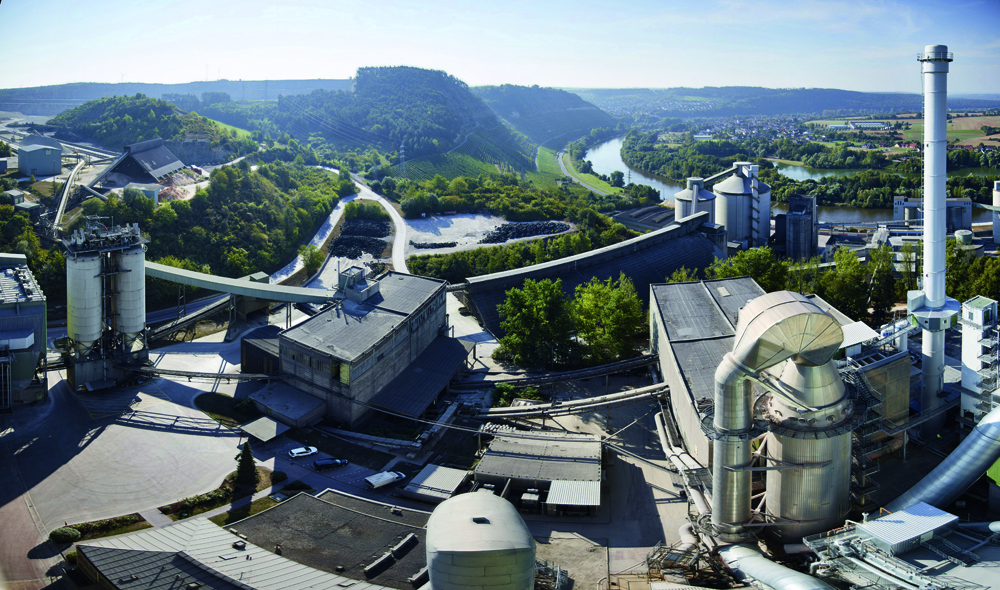
“The hook separator starts operating only when the roller conveyor sends a release signal and the photocell at the hook separator is free,” explains Becker. This prevents the tyres from falling on top of each other. Additionally, they lose any water that might have collected inside the tyre due to the impact when falling on the roller conveyor, and any dirt is removed. A checking device recognises if the tyres are damaged or if the rims are still on. Those tyres are discharged from the system.
The ‘good’ material is transported from a timing roller conveyor to a flat belt conveyor with corrugated side walls. It provides a separate compartment for each tyre. There is a transfer chute in the discharge area of the conveyor. The tyres are always guided thanks to the design of the chute.
The conveyor transports the combustible material now into the preheater tower. A scale determines the weight of the tyre on the conveyor. The result is registered by the control and evaluated for the feed regulation of the tyres. The tyres enter the tyre sluice through the inlet chute. An arched chute and a guide plate bring the tyres from their horizontal to a vertical position.
The tyres enter the tyre sluice one by one. At the rotary kiln inlet, only one of the flap valves is open at a time to avoid heat losses and flashbacks. “First the upper one opens. Then it closes and the lower flap valve opens,” says Ralf Lehmkühler, senior sales manager at BEUMER. The compressed-air tank also ensures that all flaps are closed in case of failure.
Installation and commissioning of the BEUMER waste-tyre transport system at Lengfurt plant were completed within the pre-set period. The conveying capacity can reach a maximum of three tonnes per hour, approximately 700 tyres.
Terex have announced a further significant investment in manufacturing with the completion of the second stage of the Campsie facility in Derry, Northern Ireland, one year after first opening, with an additional 30,000 square foot added. Business at Campsie is well underway, having manufactured and exported over 50 machines globally since opening in 2019. The facility continues to be a significant project with Invest NI after creating over 100 jobs for the local region. The latest investment in Campsie sees the erection of a large shed with high-capacity lifting options.
The facility currently manufactures heavy equipment for Terex Ecotec for the waste management and recycling industries and feeder conveyors for multiple MP brands. The second stage of Campsie provides the capacity for ProStack bulk-material handling and product-stockpiling equipment. The new ProStack brand offers a comprehensive portfolio of products to address the needs of key markets and applications to include aggregate, mining, recycling, agriculture, ports and terminals and many other bulk-material handling industries.
Steven Aitken, business line director for ProStack, said: “ProStack was established to respond to increasing demand for mobile conveying systems. We have ambitious plans for growth and the second stage of the Campsie facility will enable us to deliver on these plans. It is an extremely exciting time for ProStack to have this opportunity to meet growing customer demands.”
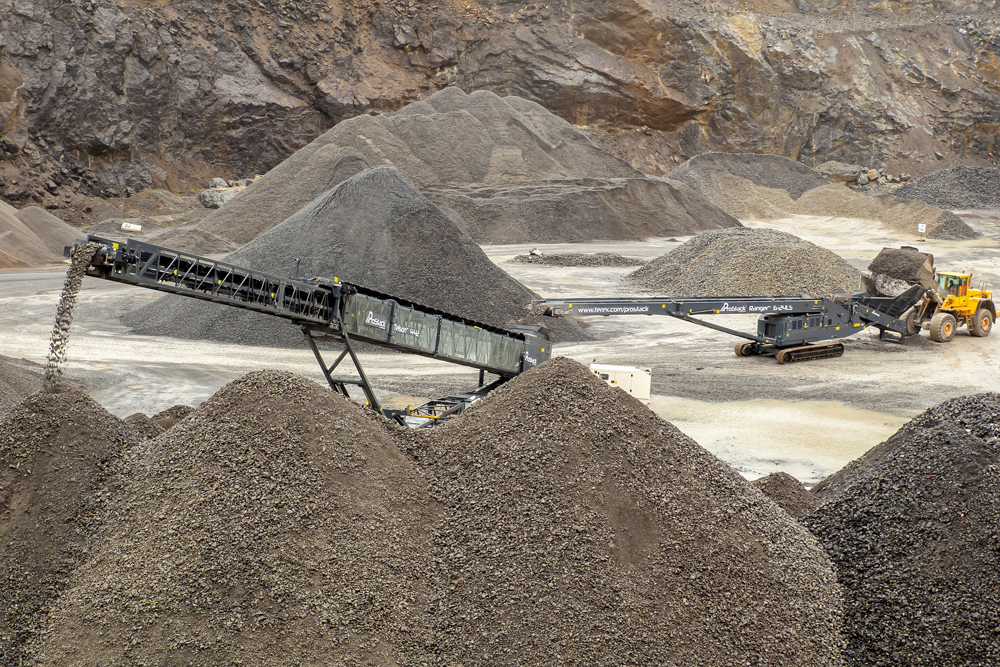
The facility is home to a highly skilled engineering team that will leverage the company’s cutting-edge engineering capabilities and lead the development of ProStack. The facility expansion provides the platform required for ProStack’s future.
“We look forward to adding more products to the ProStack portfolio in 2020 and serving our customers from our new centre of excellence” concluded Aiken.
Performance problems with conveyor components and systems can frequently be traced to improper installation or insufficient maintenance, according to U.S.-headquartered conveyor belt systems specialist Martin Engineering.
Daniel Marshall, product engineer, Martin Engineering, says: “It’s recommended that the component manufacturer or expert contractor install equipment on both new and retrofit applications. Serious performance problems stem from a lack of proper maintenance. Using a specialty contractor, also known as a ‘certified contractor’, for installation and ongoing maintenance contributes to safer and more efficient production. It also results in less unscheduled downtime, and in the long run saves money and reduces injuries.”
Marshall says that the time and resources required to train employees on equipment and certify them to conduct certain procedures, such as confined space entry and electrical work, can be a significant ongoing expense. “As workers become more experienced and gain certifications to properly maintain efficient systems, their value in the marketplace rises, and retention can become an issue. In contrast, specialty contractors must be experienced, knowledgeable and certified to conduct the appointed maintenance, and it’s up to the contracted company to retain and train that staff.
“Due to a greater emphasis on safety and the expensive consequences of unscheduled downtime, bulk handlers are being more meticulous about conveyor operation and maintenance. This increased scrutiny
includes regular cleaning of spillage, improved dust control, and additional monitoring and maintenance, exposing employees to a moving system more often. These changes introduce a variety of hazards.”
Marshall stresses how most common conveyor-related issues are found across a wide range of industries, and personnel who work around the equipment each day often become complacent about the conditions, viewing issues as an unavoidable outcome of production rather than abnormalities in need of resolution. Marshall says an experienced maintenance contractor recognises these problems and may present solutions that internal resources have overlooked. The improvements are designed to reduce employee exposure, improve workplace safety and maximise productivity. Marshall notes that maintenance programmes differ by provider and may be customisable to suit individual customers, but they generally fall into three categories: inspection/report, cleaning/servicing and full service.

He continues: “A scheduled inspection and report contract sends a specialty contractor to thoroughly examine a system – from belt health to equipment function to the surrounding environment – and identify potential issues. A report is produced that presents findings and offers solutions.
“The cleaning and servicing contracts are perhaps the most common. From spillage and silo cleaning to monitoring and changing belt cleaner blades, services can be very specific and fill gaps where maintenance crews might be overstretched. The first advantage to this is that a conveyor can be surveyed without requiring the attention of plant personnel, freeing them to go about their usual tasks. A second advantage is that the outside surveyor is an expert in proper conveyor practices and current governmental regulations.
“At the highest level, a full service and maintenance contract sends trained technicians who take accountability for monitoring, maintaining and reporting on every level of system function. They replace wear components when needed and propose required upgrades in order to maximize efficiency, safety and uptime. This provides operators with cost certainty, making it easier to project and manage the cost of operation.”
Marshall explains that increasing speeds and volumes on older conveyor systems designed for lower production levels contribute to workplace injuries and increased downtime. Capital investments in newer semi- or fully automated systems designed for higher throughput require less labour, says Marshall, but the maintenance staff need to be highly trained and specialised technicians.
Marshall adds: “Maintenance service contracts are not just a way of controlling and potentially reducing the cost of operation; they are also a safety mechanism. For example, one case study showed a 79% reduction in lost-time incidents and a 40% improvement in production using specialty services, which demonstrated payback in days from an annual specialty maintenance contract.
“Workloads may preclude staff from maintaining proper compliance or they just might not notice some violations. Outside resources take ownership of the plant’s efficient and productive use of the conveyor system and strive to improve conveyor efficiency, maximize equipment life and safety to add value to the operation.
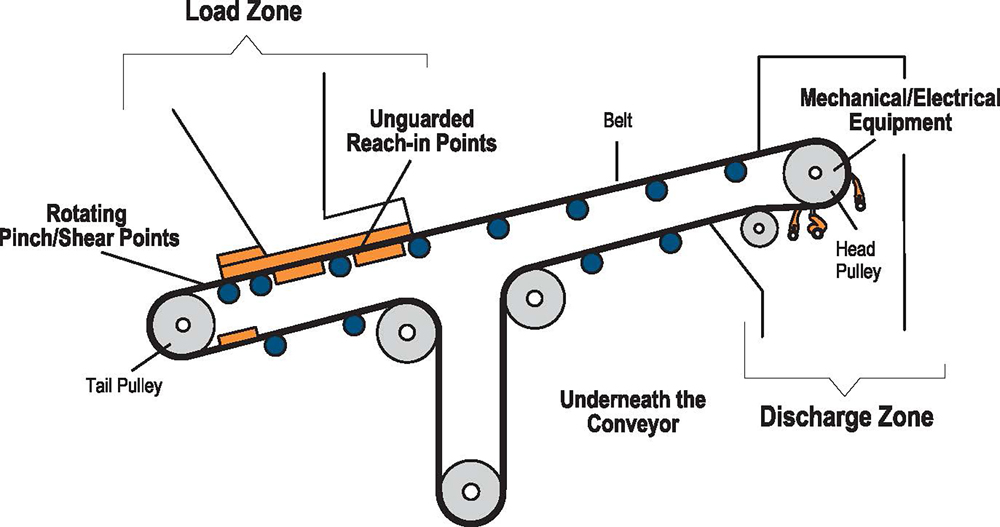
“At the core of the issue is lower operating costs and improved production. The work should match or improve efficiency regarding downtime and throughput. If the criteria of compliance, cost savings and efficiency are met, then the maintenance service contract has provided a tenable ongoing solution.”
EDGE Innovate, has launched the EDGE TSR80, a 24.3m-long, tracked mounted stacker with radial functionality. Essentially, the TSR80 has packaged all the advantages of a mobile radial stacker and that of a tracked mounted stacker into one product. The TSR80 is said to be able to self-propel across even the roughest terrains and has the capacity to create massive radial stockpiles. It is the perfect stockpiling solution for operators who frequently reposition their processing plant or want a conveyor to fulfil several different roles on-site.
The TSR80 offers operators a host of design features such as a twin driven, 1,200mm-wide discharge conveyor, hydraulic variable feed in height, adjustable operating angle, automatic radial stockpiling programming and a quick transition from transport to operational mode.
The core design principle for the TSR80 has been to provide customers with a conveyor that could create large radial stockpiles and can easily be transported both locally and around site with minimal fuss or cost. The TSR80 has been designed to fold down with its own power source and to drive onto a range of low boys and low loaders.
Smiley Monroe has opened its first US production centre in Franklin, Kentucky, in response to demand from its growing customer base in the region.
This latest expansion into the North America market by the Northern Ireland-based manufacturer of customised conveyor belts and cut rubber parts for the materials processing sectors is driven by the company’s vision to be the number one partner in the mobile equipment world, and continues to honour its core value ‘Close to our Customers’.
Smiley Monroe Inc.’s 65,000 square foot Kentucky facility has been producing two of the brand’s core products since April – namely, hot vulcanised ‘Endless’ conveyor belts and Zip Clip replacement belts – following a successful CONEXPO show in Las Vegas in March. The US operation is headed up by plant manager, Morgan Walker, who has held a number of leadership roles since joining the family-owned business as a site service team leader; and Ryan Wright, international sales manager, remains responsible for North America sales and business development.
“Manufacturing in America, for America, was a natural strategic move, and having a base in Kentucky means we can offer just-in-time delivery to our American customers,” said Chris Monroe, president of Smiley Monroe Inc.
Tim Monroe, Smiley Monroe’s marketing director, explained: “Smiley Monroe Inc. is heavily focused on manufacturing our Zip Clip replacement belts, which is the result of listening to our US customers talk about the problem of machine downtime and the amount of time and money wasted waiting for service crews and spare belts to arrive to site. Our Made-in-Kentucky Zip Clip belts make it easy to maximise conveyor uptime, increase efficiencies and reduce running costs – because working smarter, faster and with greater confidence is more critical than ever in these challenging times.”
Chris continued: “In Zip Clip Smiley Monroe Inc. is bringing fresh thinking and something genuinely new to the American market, while being well placed to satisfy volume demand for high-quality and competitively priced chevron conveyor belting which is often in short supply in the American market. Our hands-on applications experience and innovation culture means we’ll continue to develop products like our puncture-resistant ToughFlex belt, a real problem solver, particularly in the ever-evolving recycling sector, where mobile jaw and impact crushing of C&D (construction & demolition) materials, such as concrete and steel rebar, tests conveyor belts to their limits.”
Co-founded 40 years ago by Vaughan Monroe to provide conveyor belts and a vulcanising service to local quarries and mines, Smiley Monroe now exports to over 60 countries worldwide, across 10 equipment sectors – ranging from Quarrying, Construction & Demolition and Environmental to Agricultural, Recycling & Waste Management and Road Construction. The Asia market is served by Smiley Monroe India based in Hosur, southern India.






